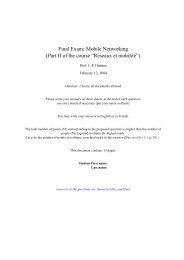LiveNet: Health and Lifestyle Networking Through ... - MIT Media Lab
LiveNet: Health and Lifestyle Networking Through ... - MIT Media Lab
LiveNet: Health and Lifestyle Networking Through ... - MIT Media Lab
Create successful ePaper yourself
Turn your PDF publications into a flip-book with our unique Google optimized e-Paper software.
tags that can be used to tag locations or objects), battery monitors,<br />
GPS units, microphones, EKG/EMG, galvanic skin response<br />
(GSR), <strong>and</strong> temperature sensors. The sensor hub also<br />
allows us to interface with a wide range of commercially available<br />
sensors, including pulse oximetry, respiration, blood pressure,<br />
EEG, blood sugar, humidity, core temperature, heat flux,<br />
<strong>and</strong> CO 2 sensors. Any number of these sensors can be combined<br />
through junctions to create a diversified on-body sensor network.<br />
Figure 1: <strong>MIT</strong>hril system, composed of the Zaurus PDA (right)<br />
with Hoarder sensor hub <strong>and</strong> physiological sensing board (top),<br />
EKG/EMG/GSR/ temperature electrodes <strong>and</strong> sensors (left) <strong>and</strong><br />
combined three-axis accelerometer <strong>and</strong> IR tag reader (bottom)<br />
2.2 Software Infrastructure<br />
The Enchantment API is an implementation of a whiteboard<br />
inter-process communications <strong>and</strong> streaming data system<br />
suitable for distributed, light-weight embedded applications. It<br />
provides a uniform structure <strong>and</strong> systematic organization for the<br />
exchange of information that does not require synchronous<br />
communications. Enchantment is intended to act as a streaming<br />
database, capturing the current state of a system (or person, or<br />
group) <strong>and</strong> can support many simultaneous clients distributed<br />
across a network <strong>and</strong> hundreds of updates a second on modest<br />
embedded hardware. We have even demonstrated the ability to<br />
use the Enchantment for b<strong>and</strong>width-intensive VoIP-style audio<br />
communications.<br />
2.3 Context Classification System<br />
The <strong>MIT</strong>hril Inference Engine is a simple, clean architecture<br />
for applying statistical machine learning techniques to the<br />
modeling <strong>and</strong> classification of body-worn sensor data. The important<br />
design features of the system are simplicity, modularity,<br />
flexibility, <strong>and</strong> implementability under tight resource constraints.<br />
The Inference Engine abstracts the data analysis into<br />
distinct steps, including the transformation of raw sensor data<br />
into features more suitable for the particular modeling task, the<br />
implementation of statistical <strong>and</strong> hierarchical, time-dependent<br />
models that can be used to classify a feature signal in real time,<br />
<strong>and</strong> the development of Bayesian inference systems which can<br />
use the model outputs for complex interpretation <strong>and</strong> decisionmaking.<br />
3. APPLICATIONS<br />
Most commercial mobile healthcare platforms have focused<br />
on data acquisition applications to date, with little attention<br />
paid to enabling real-time, context-aware applications.<br />
Companies like Digital Angel, Lifeshirt, Bodymedia have extended<br />
the basic concept of the ambulatory Holter monitor (enabling<br />
a physician to record a patient’s EKG for a small continuous<br />
period of time), which for decades was really the only<br />
common health monitor in existence.<br />
In contrast, we are building a multi-functional mobile<br />
healthcare device that is at the same time a personal health<br />
monitor, social network support enabler <strong>and</strong> communicator,<br />
context-aware agent, <strong>and</strong> multimodal feedback interface. A<br />
number of key attributes of the <strong>LiveNet</strong> System that make it an<br />
enabling distributed healthcare system include:<br />
• Wireless capability with resource posting/discovery<br />
<strong>and</strong> data streaming to distributed endpoints<br />
• Flexible sensing for context-aware applications that<br />
can facilitate interaction in a meaningful manner <strong>and</strong><br />
provide relevant <strong>and</strong> timely feedback/information<br />
• Unobtrusive, minimally invasive, <strong>and</strong> non-distracting<br />
• Continuous long-term monitoring capable of storing a<br />
wide range of physiology as well as contextual information<br />
• Real-time classification/analysis <strong>and</strong> feedback of data<br />
that can promote <strong>and</strong> enforce compliance with healthy<br />
behavior<br />
• Trending/analysis to characterize long-term behavioral<br />
trends of repeating patterns of behavior <strong>and</strong> subtle<br />
physiological cues, as well as to flag deviations from<br />
normal behavior<br />
• Enables new forms of social interaction <strong>and</strong> communication<br />
for community-based support by peers <strong>and</strong><br />
establishing stronger social ties within family groups<br />
In remainder of this section, we present a variety of realworld<br />
<strong>and</strong> potential applications of the <strong>MIT</strong>hril <strong>LiveNet</strong> System.<br />
3.1 <strong>Health</strong> <strong>and</strong> Clinical Classification<br />
The <strong>LiveNet</strong> system has proven to be a convenient, adaptable<br />
platform for developing real-time monitoring <strong>and</strong> classification<br />
systems using a variety of sensor data, including accelerometer-based<br />
activity-state classification (that can differentiate<br />
between activities such as running, walking, st<strong>and</strong>ing, biking,<br />
climbing stairs, etc.) [4], GSR-based stress detectors, accelerometer-based<br />
head-nodding/shaking agreement classifiers, <strong>and</strong><br />
audio-based speaking state (talking/not talking, prosidy) classifiers<br />
which can help characterize conversation dynamics [5].<br />
Work on these real-time classifiers has also been extended<br />
to include critical health conditions. Examples of current collaborations<br />
between the Human Dynamics Group <strong>and</strong> clinicians<br />
include a study on the effects of medication on the dyskinesia<br />
state of Parkinson’s patients with a Harvard neurologist [6], a<br />
pilot epilepsy classifier study with the University of Rochester<br />
Center for Future <strong>Health</strong>, a depression medication study with the<br />
MGH Department of Neuroscience, <strong>and</strong> a hypothermia study<br />
with the ARIEM (Advanced Research in Environmental Medicine)<br />
at the Natick Army <strong>Lab</strong>s [7].<br />
The sensor data <strong>and</strong> real-time classification results from a<br />
<strong>LiveNet</strong> system can also be streamed to off-body servers for<br />
subsequent processing, trigger alarms or notify family members<br />
<strong>and</strong> caregivers, or displayed/processed by other <strong>LiveNet</strong> systems




